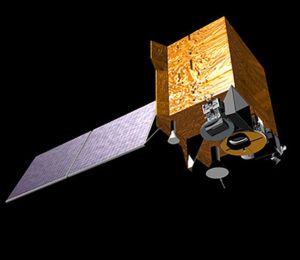This story originally appeared on the CCAC website.
In an important next step for global air quality monitoring, this week South Korea successfully launched a satellite that is the first in a network of three that will eventually provide coverage for Asia, North America, and Europe. The satellite was launched into orbit aboard an Arianespace Ariane 5 rocket on February 18, from the Guiana Space Center in French Guiana.
Aboard the Korean Aerospace Research Institute’s Cheollian 2B satellite is South Korea’s Geostationary Environment Monitoring Spectrometer (GEMS) instrument. GEMS is designed to improve early warnings for dangerous pollution events across the Asia-Pacific region and monitor long-term climate change.

Artist illustration of the GEMS spacecraft (Ball Aerospace)
Over its 10-year mission GEMS will investigate chemical concentrations critical to air quality and climate change, such as nitrogen dioxide, sulfur dioxide, formaldehyde, ozone, and other aerosols. It is expected to identify the source of fine dust (PM2.5) flowing into Korea by observing fine dust and fine dust-inducing substances in East Asia for the first time.
“The development of Cheollian 2B as scheduled has enabled Korea to participate in the global environmental surveillance system in a leading position along with the US and Europe. We will continue to strengthen our satellite development capabilities to help Korea play a major role in global environmental monitoring and disaster response,” said Choi Weon-ho, director of Space, Nuclear & Big Science Policy at South Korea’s Ministry of Science and ICT.
According to information provided by the GEMS manufacturer, Ball Aerospace: “The GEMS mission will enable Korean scientists to assess and forecast air quality, monitor regional trans-boundary pollution and Asian dust, and understand the long-term effect of aerosols in climate change. This information will help reduce economic loss by improving climate change predictions. Early warning of natural disasters and pollution events will also help save lives.”
GEMS will monitor atmospheric gases over Asia hourly during daytime from a geostationary, or fixed, orbit 35,786 kilometres above the equator. It marks a significant leap forward in scientists’ ability to monitor air pollution from space. GEMS can perform a 5,000 kilometre East/West scan in less than 30 minutes, and will collect images of required geographical locations at least 8 times a day.
A sister instrument to NASA’s Tropospheric Emissions: Monitoring of Pollution (TEMPO), GEMS will be the first satellite instrument in a constellation of three satellite instruments that will revolutionize the way scientists observe air quality over significant swaths of the Northern Hemisphere.
GEMS is nearly identical to TEMPO, which is scheduled to launch into geostationary orbit in 2022. TEMPO will make hourly daytime measurements of air quality over North America. The European Space Agency’s Sentinel-4, currently in development, will observe air quality over Europe.
All three instruments will provide data products that will improve scientists’ ability to understand and forecast air quality around the Northern Hemisphere.
Cheollian 2B will also be used for the protection of the marine environment, management of water resources, and marine safety by observing marine pollutants such as green algae, red tide, and oil spills in the waters of the Korean Peninsula.
Hero image courtesy of Arianespace.